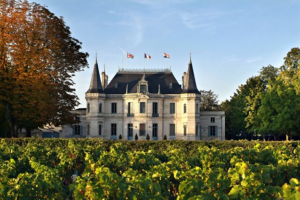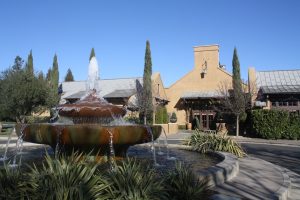It’s impossible to draw meaningful comparisons between wine tasting in France and California. They’re both too large with too many wine growing regions to be able to say anything about one place without having a counterexample from another. So let’s narrow the scope of the comparison to the two premier winemaking regions in each. That would be Napa Valley and Bordeaux, although the people of Burgundy might make a claim as well.
We suppose that there were people who traveled to both regions for wine tasting in the 19th and early 20th centuries. We can only speak to the wine tasting experiences of the last quarter of the 20th century onward.
Let’s stipulate a few differences up front. They speak French in Bordeaux; their history goes back thousands of years and the restaurants all serve French food. In Napa Valley, they speak English (and a lot of Spanish); the history there is hundreds of years old and the restaurants there serve cuisines from all around the world.
 Château Palmer in Margaux, in the Medoc. Photo courtesy of The Drinks Business.
Château Palmer in Margaux, in the Medoc. Photo courtesy of The Drinks Business.
Both are beautiful, but in different ways. Napa Valley has a broad lowland with mountain ranges on both sides. Bordeaux has three major vineyard areas: Macon on the left bank of the Garonne River, Pomerol/St. Emilion on the right bank and Graves/Sauternes south of the city of Bordeaux. It’s easy to drive the length of Napa Valley in a few hours. You need a few days to see all of Bordeaux.
 Franciscan winery in Rutherford, Napa Valley.
Franciscan winery in Rutherford, Napa Valley.
Napa Valley’s wineries have evolved from farmhouses to what we term Napa Palaces. In Bordeaux they have real palaces, or at least châteaux. There are few if any rustic wineries left in Napa Valley. In Bordeaux many of the smaller producers don’t have the magnificent castles that the famous names have, although they all seem to call themselves Château This or Domaine That.
In our earliest travels to both, it was a simple matter of driving up to a winery and asking for a taste of their wines. If money ever changed hands it was only a few dollars; in Napa Valley they would throw in a free glass. There are still some places where walk-in tastings are available in Napa Valley. Those in Bordeaux are generally lower quality houses, mostly in the town of St. Emilion. The better Bordeaux tastings have long since been by appointment only. This trend was apparent in Napa Valley too, prior to the pandemic. Now it’s more of a general rule.
In Bordeaux, a tasting means blends featuring either Cabernet Sauvignon (Macon and Graves) or Merlot (St. Emilion). There are some whites, most based on Semillon grapes. Napa Valley tastings offer much greater variety: all the Bordeaux grapes, and those of Burgundy and the Rhône.
The wineries in Napa Valley are closer to one another. You can easily visit five or six wineries and not travel more than a mile. That’s just not the case in Bordeaux. On the other hand, traffic is much worse in Napa Valley (especially on Route 29) than on the main roads in Bordeaux.
So finally, which region makes better wine? That’s a question often debated at our dinner table and it has not yet been resolved. You’d better decide for yourself.